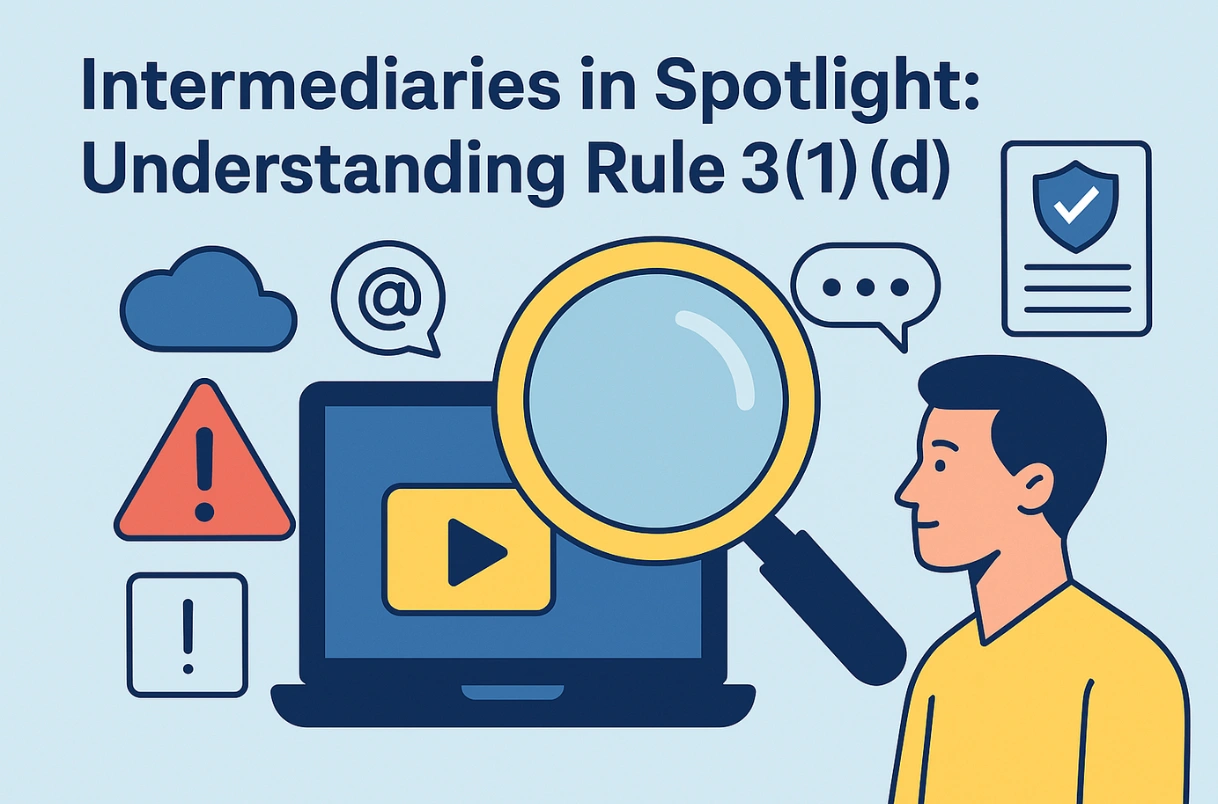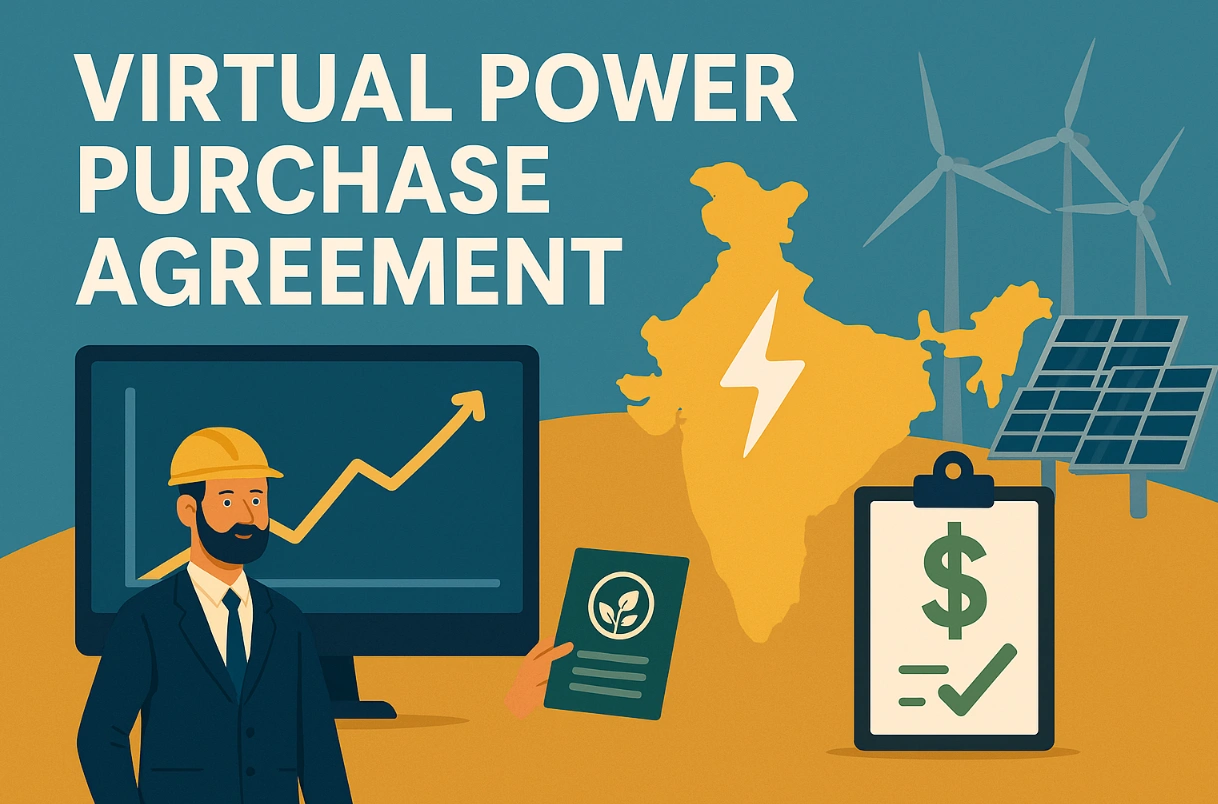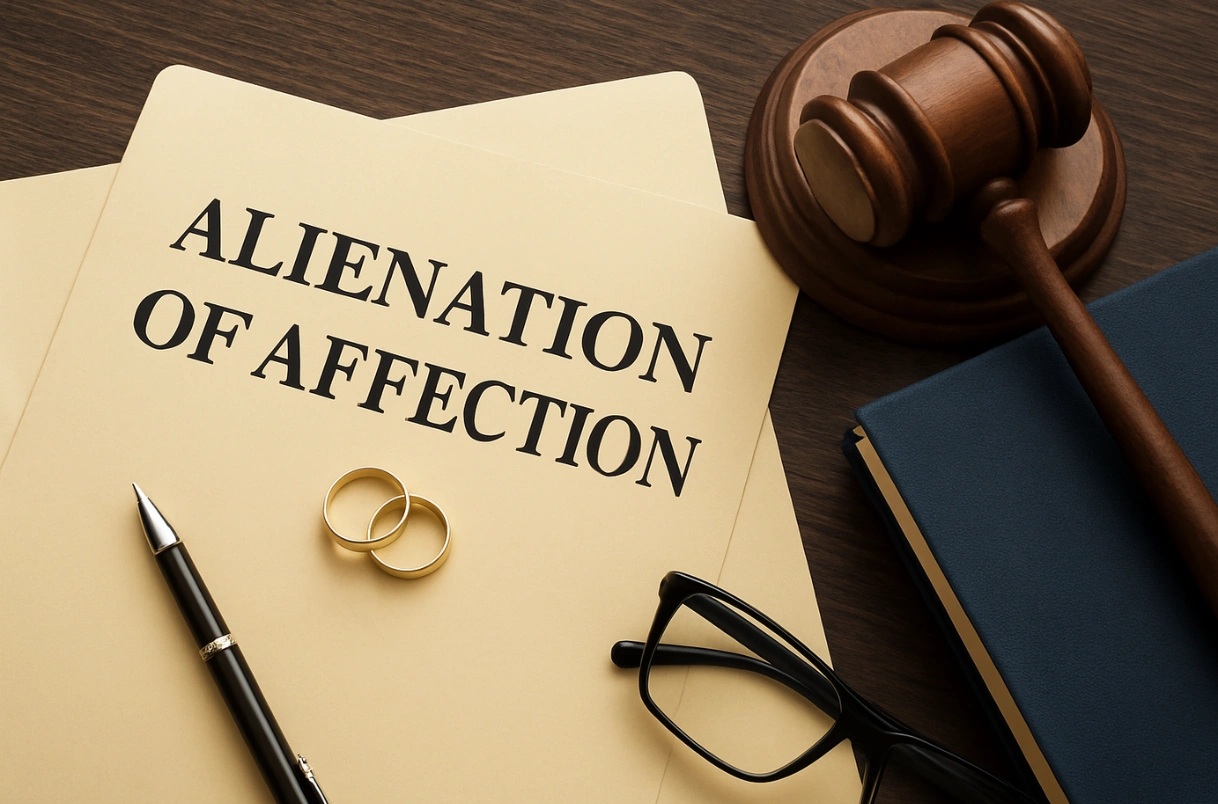Intermediaries in Spotlight: Understanding Rule 3(1)(D)

By – Astha Sehgal
Table of Contents
INTRODUCTION
The Ministry of Electronics and Information Technology (“MeitY”) has recently notified Information Technology (Intermediary Guidelines and Digital Media Ethics Code) Amendment Rules, 2025 (“the Amendment”), amending Rule 3(1)(d) of the Information Technology (Intermediary Guidelines and Digital Media Ethics Code) Rules, 2021 (“IT Rules”) . Effective 15 November 2025, the Amendments signal India’s next step toward a more transparent and accountable digital ecosystem, one that balances enforcement with procedural fairness.1
The IT Rules were first notified on 25 February 2021 and subsequently amended in October 2022 and April 2023, forms the backbone of India’s intermediary liability framework, aimed at promoting online safety, security, and accountability. Recognizing the rapidly evolving nature of the internet, the Indian Government has periodically updated these IT Rules to address emerging challenges and public concerns.
Online safety has been a recurring concern globally, especially with the rise in cases involving violation of personality and privacy rights, being brought before Indian courts. A notable instance is the case of Sadhguru Jagadish Vasudev & Anr. v. Igor Isakov & Ors. (2024 SCC OnLine Del 3267), wherein the Hon’ble Delhi High Court directed the Department of Telecommunications (DoT) and MeitY to endeavour to develop and implement a technology capable of identifying identical infringing content. This was aimed at obviating the need for the plaintiffs to repeatedly approach the authorities for takedown of the same or substantially similar content appearing on various online platforms.2
Building on these concerns, the 2025 Amendments to the IT Rules place renewed emphasis on strengthening content takedown mechanisms, to address long-standing criticism surrounding their lack of uniformity, procedural clarity, and transparency.
UNDERSTANDING INTERMEDIARIES AND RULE 3(1)(D)
The Information Technology Act, 2000 (“IT Act”) defines an intermediary under Section 2(w) as
“[(w) ―intermediary‖, with respect to any particular electronic records, means any person who on behalf of another person receives, stores or transmits that record or provides any service with respect to that record and includes telecom service providers, network service providers, internet service providers, web-hosting service providers search engines, online payment sites, online-auction sites, online-market places and cyber cafes;]”3
Given the pivotal role of ‘intermediaries’ in the digital ecosystem, intermediaries are required to observe certain due diligence obligations under the IT Rules. Rule 3(1)(d) specifically deals with how intermediaries must respond to orders or notifications from the Government or its authorised agencies relating to the removal or disabling of unlawful information. Rule 3(1)(d) forms part of the due-diligence obligations that every intermediary must observe to retain “safe-harbour” protection under Section 79 of IT Act. The provisions of Rule 3(1)(d) prior to the Amendment are reiterated below:
“3. (1) Due diligence by an intermediary:
(d) an intermediary, on whose computer resource the information is stored, hosted or published, upon receiving actual knowledge in the form of an order by a court of competent jurisdiction or on being notified by the Appropriate Government or its agency under clause (b) of sub-section (3) of section 79 of the Act, shall not host, store or publish any unlawful information, which is prohibited under any law for the time being in force in relation to the interest of the sovereignty and integrity of India; security of the State; friendly relations with foreign States; public order; decency or morality; in relation to contempt of court; defamation; incitement to an offence relating to the above, or any information which is prohibited under any law for the time being in force:
Provided that any notification made by the Appropriate Government or its agency in relation to any information which is prohibited under any law for the time being in force shall be issued by an authorised agency, as may be notified by the Appropriate Government:
Provided further that if any such information is hosted, stored or published, the intermediary shall remove or disable access to that information, as early as possible, but in no case later than thirty-six hours from the receipt of the court order or on being notified by the Appropriate Government or its agency, as the case may be:
Provided also that the removal or disabling of access to any information, data or communication link within the categories of information specified under this clause, under clause (b) on a voluntary basis, or on the basis of grievances received under sub-rule (2) by such intermediary, shall not amount to a violation of the conditions of clauses (a) or (b) of sub-section (2) of section 79 of the Act;4
Definition and Scope under the IT Act
This rule obliges intermediaries, such as social media platforms, messaging services, e-commerce marketplaces, and hosting providers, to remove or disable access to unlawful information once they receive ‘actual knowledge’ of its illegality, either through:
- a court order, or
- a notification from the Appropriate Government or its authorised agency.
This provision ensures that intermediaries do not turn a blind eye to unlawful content once they are specifically made aware of it. However, in the absence of a clear and uniform process, and with vague or confusing takedown notices being issued by different authorities, platforms often struggled to interpret their obligations.
KEY HIGHLIGHTS OF THE AMENDMENT AND IMPACT ON INTERMEDIARIES5
A. Key Highlights:
The Amendment to Rule 3(1)(d) of the IT Rules, introduces three structural safeguards that collectively enhance transparency and accountability. The provisions of the amended Rule 3(1)(d) are reiterated below:6
“(d) an intermediary, on whose computer resource the information which is used to commit an unlawful act which is prohibited under any law for the time being in force in relation to the interest of the sovereignty and integrity of India; security of the State; friendly relations with foreign States; public order; decency or morality; in relation to contempt of court; defamation; incitement to an offence relating to the above, or any information which is prohibited under any law for the time being in force is hosted, displayed, published, transmitted or stored shall, upon receiving the actual knowledge under clause (b) of sub-section (3) of section 79 of the Act on such information, remove or disable access to such information within thirty-six hours of the receipt of such actual knowledge, and such actual knowledge shall arise only in the following manner, namely:—
- by an order of a court of competent jurisdiction; or
- (ii) a reasoned intimation, in writing,–
(I) issued by an officer authorised for the purpose of issuing such intimation by the Appropriate Government or its agency, being not below the rank of Joint Secretary or an officer equivalent in rank or where an officer at such rank is not appointed, a Director or an officer equivalent in rank, to the Government of India or to the State Government, as the case may be, and, where so authorised, acting through a single corresponding officer in its authorised agency, where such agency is so appointed:
Provided that where such intimation is to be issued by the police administration, the authorised officer shall not be below the rank of Deputy Inspector General of Police, especially authorised by the Appropriate Government in this behalf:
Provided further that all such intimations shall be subject to periodic review by an officer not below the rank of the Secretary of the concerned Appropriate Government once in every month to ensure that such intimations are necessary, proportionate, and consistent with clause (b) of sub-section (3) of section 79 of the Act and this clause;
(II) clearly specifying the legal basis and statutory provision invoked, the nature of the unlawful act, and the specific uniform resource locator, identifier or other electronic location of the information, data or communication link required to be removed or disabled;”.
To better understand the significance of the changes, it is important to examine the key safeguards introduced through the Amendments:7
- Elevated Level of Authorization: Under the amended framework, any government direction or intimation to intermediaries for the removal or disabling of unlawful content must now originate only from a senior officer not below the rank of Joint Secretary, or an equivalent rank. In cases where no such position exists, the power may be exercised by a Director or an officer of equivalent seniority, and, where authorised, may be channelled through a single corresponding officer within the authorised agency designated for such communications. Whereas, for law enforcement authorities, this responsibility is further restricted, only an officer not below the rank of Deputy Inspector General of Police (DIG), and specially authorised for the purpose, may issue such takedown intimations.
This elevation curtails arbitrary takedown and embeds accountability at the decision-making level.
- Requirement of a ‘Reasoned Intimation’: The Amendment substitutes the earlier broad term ‘notifications’ with ‘reasoned intimation’, thereby aligning the IT Rules with the requirement of ‘actual knowledge’ under Section 79(3)(b) of the IT Act8 and ensuring greater clarity and precision in compliance. Each intimation must now specify:
- the precise legal basis under which the information is considered unlawful,
- the nature of the alleged violation, and
- the exact electronic link, URL, or identifier of the content to be removed.
This ensures that intermediaries receive sufficiently detailed and legally grounded directions, enabling them to act in an informed and proportionate manner.
- Monthly Review of Issued Directions: The Amendment introduces a periodic review mechanism, under which all intimations issued pursuant to Rule 3(1)(d) must be reviewed every month by an officer not below the rank of Secretary to the Appropriate Government. The review process introduces an internal check within the administrative system, promoting accountability and ensuring that takedown actions do not persist beyond what is justifiable.
B. Impact on intermediaries:
The revised framework provides intermediaries with greater procedural clarity but also imposes enhanced compliance responsibilities, such as:
- Operational readiness: Platforms will now need better compliance structures that can confirm / identify the source or who issued a takedown order and whether it follows proper procedure as laid down. They must also be able to monitor and review deadlines, which means investing in better compliance tools, automation, and internal coordination.
- Documentation and audit trail: Platforms must now keep detailed records of every takedown request, including why it was issued, when it was acted upon, and what reviews followed. Keeping this documentation will help demonstrate that the platform acted responsibly and in compliance with the law if its actions are ever questioned by regulators or courts.
- Strengthened safe-harbour defence: The Amendment strengthens intermediaries’ safe-harbour protection under Section 79 of the IT Act by providing a clearer definition of what constitutes valid ‘actual knowledge’. Intermediaries that act promptly and in good faith upon receiving reasoned and properly issued intimations from competent authorities can more effectively shield themselves from liability arising out of user-generated content.
THE POLICY RATIONALE
This latest amendment represents an attempt by the Government to strike a balance between competing policy objectives i.e. protecting national security, public order, and online safety on one side, while safeguarding freedom of expression and procedural fairness on the other. The Amendment is driven by a set of clearly defined policy objectives:
i) Enhancing transparency:
By requiring that takedown directions be accompanied by ‘reasoned and specific intimations’, the Amendment aims to ensure that both intermediaries as well as the affected users are made aware of the precise/ exact grounds for content removal. This makes the process more transparent and helps create a fairer online system.
ii) Safeguarding rights:
Introducing a periodic review mechanism ensures that restrictions on online content remains proportionate, necessary, and subject to oversight. This procedural safeguard aligns the regulatory framework with the principles of natural justice and also reinforces the idea that content restrictions cannot be indefinite or arbitrary but must withstand periodic scrutiny to justify their continuation. By mandating such reviews, the Amendment seeks to strike a balance between protecting users from harmful content while preserving the fundamental right to free expression.
iii) Clarity for Intermediaries:
By introducing ‘detailed and reasoned intimations’, the Amendment provides intermediaries with clearer guidance on how to comply with the law, reducing uncertainty in the takedown process. This ensures that platforms understand not only what content must be removed, but why such action is necessary. Greater transparency in the communication of reasons also helps intermediaries maintain consistency in enforcement decisions, avoid over-blocking legitimate content, and demonstrate good-faith compliance in the event of regulatory or judicial scrutiny.
CONCLUSION
The Amendment to Rule 3(1)(d) of the IT Rules is a welcome and much-needed recalibration of India’s content regulation regime. By embedding higher-level authorisation, reasoned decision-making, and periodic review, the Government has signalled its commitment to fostering a more transparent and accountable digital governance framework focused on a balanced approach between the interests of content creators, regulators, and consumers. Much will depend on how faithfully these principles are implemented in practice, but the direction of reform is unmistakably positive i.e. a framework that upholds enforcement efficiency without sacrificing due process or fundamental freedoms.
In an era where digital platforms shape both discourse and democracy, such procedural safeguards are not just administrative necessities, they are constitutional imperatives. In an age of AI, India’s digital portfolio now speaks the language of accountability !.
FAQs
-
What are the Intermediary Guidelines and Digital Media Ethics Code Rules, 2021?
These Rules provides for India’s intermediary liability framework, aimed at promoting online safety, security, and accountability in India.
-
What is Rule 3(1)(d) under the IT Rules?
Rule 3(1)(d) forms part of the due-diligence obligations that every intermediary must observe to retain “safe-harbour” protection under Section 79 of IT Act
-
What are the 2025 amendments to the IT Rules?
The 2025 amendment to Rule 3(1)(d) introduces three major structural safeguards that enhance transparency and accountability in India’s content takedown regime. These include: (i) an elevated level of authorisation, ensuring that takedown orders can only be issued by senior government officers; (ii) a requirement for a detailed and “reasoned intimation,” mandating that each takedown request specify the legal basis, nature of violation, and exact electronic link; and (iii) a monthly review mechanism by a senior officer to ensure that all issued directions remain necessary, proportionate, and consistent with statutory requirements.
-
How does Rule 3(1)(d) impact intermediary liability in India?
The amended Rule 3(1)(d) reshapes intermediary liability by strengthening procedural clarity and compliance discipline. Intermediaries must now maintain operational readiness through structured compliance systems that verify the validity and source of takedown orders. They are required to preserve detailed documentation and an audit trail for each takedown, including the rationale, timing, and subsequent review. Most importantly, the Amendment fortifies the safe-harbour protection under Section 79 by clarifying what constitutes valid “actual knowledge,” thereby enabling intermediaries to defend themselves more effectively when acting promptly and in good faith.
-
What is meant by a ‘reasoned intimation’ under the amended rules?
A ‘reasoned intimation’ refers to a written direction issued by an authorised officer, clearly outlining the legal and factual basis for removing or disabling access to online content. Each intimation must specify (a) the precise statutory provision invoked, (b) the nature of the alleged violation, and (c) the exact electronic location, such as URL or identifier, of the content to be removed. This requirement ensures that intermediaries receive detailed and legally grounded directions, reducing ambiguity and the risk of overbroad content removal.
-
Who can issue takedown orders under the new framework?
Under the amended framework, only senior officials are empowered to issue takedown orders or intimations. Such directions must originate from an officer not below the rank of Joint Secretary, or an equivalent rank such as Director, duly authorised by the Appropriate Government or its agency. For law enforcement authorities, this power is further limited to officers not below the rank of Deputy Inspector General of Police (DIG), specially authorised for this purpose. This elevation in authorisation ensures accountability, consistency, and safeguards against arbitrary or excessive takedown actions.
-
How does the amendment improve transparency in online content regulation?
The Amendment enhances transparency by mandating that all takedown directions be accompanied by reasoned and specific intimations. This ensures that intermediaries and, by extension, affected users understand the precise grounds for content removal. By requiring explicit legal and factual justification for each order, the amendment promotes procedural fairness, discourages overreach, and strengthens public confidence in the content moderation process.
-
What procedural safeguards have been introduced for intermediaries?
The Amendment introduces a monthly review mechanism, under which all takedown intimations issued by authorised officers must be reviewed by an officer not below the rank of Secretary to the Appropriate Government. This safeguard ensures that restrictions on online content remain proportionate, necessary, and subject to continuous oversight. It aligns the regulatory process with the principles of natural justice by preventing indefinite or arbitrary takedown orders and ensuring periodic scrutiny of ongoing restrictions.
-
How does this amendment affect safe harbour protection under Section 79 of the IT Act?
The Amendment reinforces intermediaries’ safe-harbour protection by providing a clearer definition of what constitutes valid “actual knowledge.” Intermediaries that act swiftly and in good faith upon receiving reasoned, lawful, and properly issued intimations from competent authorities can more confidently claim immunity from liability for third-party content. This clarity reduces compliance uncertainty, encourages responsible moderation, and strengthens India’s intermediary protection framework.
-
What is the broader impact of the IT Rules amendment on digital freedom in India?
The 2025 Amendment represents a significant recalibration of India’s digital governance framework. By embedding higher levels of authorisation, mandating reasoned decision-making, and instituting periodic reviews, the government seeks to balance national security and public order with the preservation of freedom of expression. It signals a shift toward a more transparent, accountable, and proportionate regulatory model that protects users, ensures due process, and upholds India’s constitutional values in the digital age.
References –
- https://www.pib.gov.in/PressReleasePage.aspx?PRID=2181719
- https://delhihighcourt.nic.in/app/showlogo/1760792237_084924e224ef2d22_589_5782025.pdf/2025
- https://www.indiacode.nic.in/bitstream/123456789/13116/1/it_act_2000_updated.pdf
- https://www.meity.gov.in/static/uploads/2024/02/Information-Technology-Intermediary-Guidelines-and-Digital-Media-Ethics-Code-Rules-2021-updated-06.04.2023-.pdf
- https://www.meity.gov.in/static/uploads/2025/10/90dedea70a3fdfe6d58efb55b95b4109.pdf
- https://www.meity.gov.in/static/uploads/2025/10/90dedea70a3fdfe6d58efb55b95b4109.pdf
- https://www.pib.gov.in/PressReleasePage.aspx?PRID=2181719
- https://www.indiacode.nic.in/bitstream/123456789/13116/1/it_act_2000_updated.pdf


